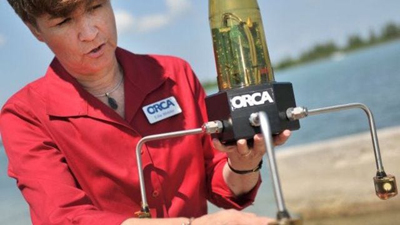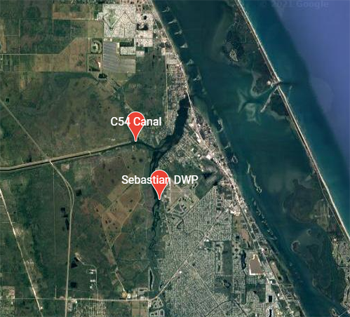About Us
Who Protects Water?
Rights of Nature
The first 20 years
Awards
Email Updates
Directors & Officers
Committees
Photo Gallery
Membership Info/Renew
Links
News and Information
Library/Newsletters
Newsletters
Board agendas & meeting notes
Invasive Plant Information
What's in a Name?
What is a Watershed?
What is a Slough?
Like us on Facebook

St. Sebastian River Water Quality Sampling and Parameters
CWC bacteria sampling project
Members of the FSSR assisted the Clean Water Coalition of Indian River County in sampling water in the St. Sebastian River for their enteric bactera monitoring project. The CWC sampled for the bacteria in the Indian River Lagoon, in the Vero Beach area, and asked for assistance in sampling the River. To learn more about enteric bacteria and their project, as well as test results, visit their website at www.cwcirc.org/water-quality-monitoring.

Photo: TCPalm.com
ORCA's Kilroy Monitoring Network
The Ocean Research and Conservation Association (ORCA) of Ft. Pierce installed two of their Kilroy monitoring devices in separate locations of the St. Sebasitan River in early summer 2020.

Founded by Dr. Edie Widder, ORCA is "the nation's first technology-based marine conservation" organization. Dr. Widder developed the Kilroy as a low-cost water-quality monitoring device to provide continuous, real-time, multi-parameter sampling. She nicknamed the device Kilroy after the World War II meme "Kilroy was here," and accompanying cartoon figure, which turned up in many unexpected places on military hardware. Dr. Widder's vision is for widespread deployment (similar to Kilroy) of the device to detect and map pollutants and biological processes responding to those pollutants, helping to understand a waterbody's impariment and pinpoint causes and sources.
Visit ORCA's Kilroy system web page for more information. On their site, click on the "Kilroy Live Feed" link for a map of locations of the installed devices. Once you zoom into the St. Sebastian River, click on a device location to display a list of sampling parameters, then select a parameter of interest.
You may also be interested in the ORCA video: "The ORCA Minute: Let's Talk About Kilroys" showing how to use their Kilroy site.
Additionally, ORCA has a Pollution Mapping Citizen Science program where ORCA scientists and community members are working together to gather data needed to optimize conservation efforts. In order to understand complex ecological problems, you need large amounts of data that is consistently collected over a long period of time. For information about this program and to view their pollution mapping data, visit their Citizen Science & Education web page.
Florida Water Quality Standards
Florida is required under the EPA's Clean Water Act to classify the state's waterbodies, based upon their uses, and set limitations for each, of specific parameters and pollutants. The state is also required to determine when a waterbody does not meet those standards and therefore is considered impaired, i.e. the "303(d) list." For waterbodies that are impaired the state is required to determine a TMDL (Total Maximum Daily Load) for the pollutant(s) or condition causing the impairment, and apportion and implement required reductions of the constituent(s) causing the impairment in order to return the waterbody to federal and state standards. Those standards are set out in the Act and by statute 62-302 of the Florida Administrative Code. For more information, visit the Florida Department of Environmental Protection web page.
Segments of the St. Sebastian River are considered impaired and have an established TMDL(s). For more information, visit the the FL DEP Water Quality Evaluation and TMDL Program web page, or the new FL DEP "Protecting FL Together" Water Quality Status Map.
Below is a description of the parameters measured by ORCA's Kilroy monitoring system and their limitations set by Florida.
- Dissolved oxygen - Florida's statute 62-302.533 provides conditional requirements for various waters in the state, but in general, the level of DO in the St. Sebastian River should remain at 38% or greater.
- FDOM - Colored, or chromophoric dissolved organic matter (CDOM), is a naturally occurring dissolved matter that absorbs UV light in water. It's usually made up of tannins that are released from the breakdown of plant material. A fraction of CDOM fluoresces when it absorbs light of a certain spectrum, and is called fluorescent dissolved organic matter, or FDOM. CDOM/FDOM is used to measure the relative amount of dissolved organic material (DOM) in the water. Although it is naturally occurring, human influence through aspects such as logging, agriculture, effluent discharge and wetland drainage can affect the levels of CDOM in freshwater and estuarine systems. It is vital to measure the levels of CDOM/FDOM and understand their trends because they can have a significant effect on aquatic ecosystems. Raised levels of CDOM/FDOM can inhibit the growth of phytoplankton and limit photosynthesis, damaging the food chain and limiting the production of oxygen in water bodies.[1] For more information, you may be interested in a report by Chinese researchers, and provided by the US National Center for Biotechnology Information here. There is no state target level for FDOM.
- ORP - Oxidation reduction potential is a measure of a substance's ability to either oxidize or reduce another substance. A positive reading on an ORP meter means that the substance is an oxidizing agent; a negative reading indicates that the substance is a reducing agent. ORP is integral to water testing because it indicates how sanitized or contaminated water is based on its oxidation and reduction properties. In order to be safe to consume, recycle, or come in contact with our skin, water is treated with a sanitizing agent to have a higher oxidation potential, producing a higher ORP reading. In addition to being used to monitor water quality in chlorinated pools, ORP meters are widely used in the food processing and water treatment industries to ensure that water is free of contaminants and safe to recycle or consume. Bottled water or tap water that is contaminant-free will have a positive ORP value.[2] There is no state level for ORP in open waterbodies.
- pH - pH is a measure of how acidic/basic water is. The range goes from 0 to 14, with 7 being neutral. pHs of less than 7 indicate acidity, whereas a pH of greater than 7 indicates a base. pH is really a measure of the relative amount of free hydrogen and hydroxyl ions in the water. The pH of water determines the solubility (amount that can be dissolved in the water) and biological availability (amount that can be utilized by aquatic life) of chemical constituents such as nutrients (phosphorus, nitrogen, and carbon) and heavy metals (lead, copper, cadmium, etc.). For example, in addition to affecting how much and what form of phosphorus is most abundant in the water, pH also determines whether aquatic life can use it. In the case of heavy metals, the degree to which they are soluble determines their toxicity. Metals tend to be more toxic at lower pH because they are more soluble.[3] There is no state target value for pH of open waterbodies.
- Salinity PSU - is the amount of salt dissolved in water. PSU stands for Practical Salinity Unit. One PSU is equivalent to one part per thousand. Ocean salinity is 35 parts per thousand or 35 PSU. For more information, you may be interested in a discussion of salinity by the U.S. Geological Service here. There is no state target level for salinity of fresh, surfaces waters.
- Turbidity NTU - Turbidity is the measure of relative clarity of a liquid. It is an optical characteristic of water and is a measurement of the amount of light that is scattered by material in the water when a light is shined through the water sample. The higher the intensity of scattered light, the higher the turbidity. Material that causes water to be turbid include clay, silt, very tiny inorganic and organic matter, algae, dissolved colored organic compounds, plankton and other microscopic organisms. High concentrations of particulate matter affect light penetration and ecological productivity, recreational values, and habitat quality.... In streams, increased sedimentation and siltation can occur, which can result in harm to habitat areas for fish and other aquatic life. Particles also provide attachment places for other pollutants, notably metals and bacteria. For this reason, turbidity readings can be used as an indicator of potential pollution in a water body.[4] NTU is the unit of measure for turbidity and stands for nephelometric turbidity units. The state limit for turbidity is less than or equal to 29 NTUs above natural background conditions.
- Nitrogen - the state of Florida limit for nitrogen is based upon a 30-day average from a complicated formula, as set out in statute 62-302.530 of the Florida Administrative Code. The statute includes the following description of limitations of nutrient discharges: "The discharge of nutrients shall continue to be limited as needed to prevent violations of other standards contained in this chapter. Man-induced nutrient enrichment (total nitrogen or total phosphorus) shall be considered degradation in relation to the provisions of Rules 62-302.300, 62-302.700, and 62-4.242, F.A.C. In no case shall nutrient concentrations of a body of water be altered so as to cause an imbalance in natural populations of aquatic flora or fauna."
- Phosphate - there is no numerical value for phosphates specified, but see the discussion about nutrients, above, for nitrogen.
Footnotes
[1] Aquaread Water Monitoring Instrumnts - "What is CDOM/FDOM and Why is it Necessary?"
[2] JENCO - "Water Quality 101: What Is ORP in Water Testing?"
[3] U.S. Geological Service
[4] Turbidity and Water, U.S. Geological Service
